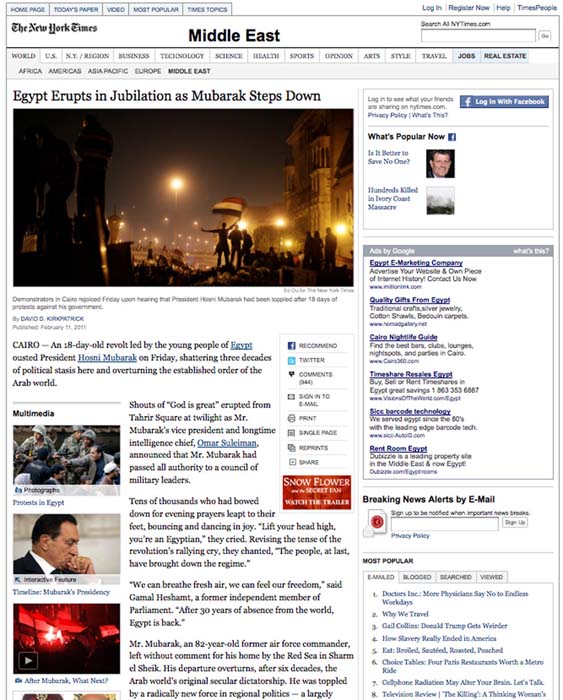|
Capturing the Moment
Thomas Friedman (ALU '74) and Nicholas Kristof (ALU '84) flew in to
Tahrir to witness history in the making 
All of a sudden, Egypt was
everywhere. From Al Jazeera
to CNN to print media, the
Egyptian Revolution was front-page
news. The New York Times's opinion
page was no exception, dedicating
column-inch after column-inch to each
new progression of the revolution.
Indeed, among its group of columnists
are two who share more than just the
distinction of a New York Times byline:
Thomas Friedman (ALU '74) and
Nicholas Kristof (ALU '84), who share
five Pulitzer Prizes between them, are
both AUC alumni.
Both columnists approached their
coverage with an international mindset
rooted in a study of Middle Eastern
affairs. Friedman, who came to AUC
in 1974 to study Arabic, later went on
to earn a Marshall Scholarship
at Oxford University. Early
reporting assignments took
him to Beirut, where he later
served as bureau chief for The
New York Times, a post he also
held in Israel. Friedman has
been The New York Times's
foreign affairs columnist since
1995. Kristof, who came to
AUC to study at the Arabic
Language Institute in 1983
after completing a Rhodes
Scholarship, is best known for
his coverage of humanitarian
and human rights topics and
has written extensively on
Darfur. He has been working
for The New York Times since 1984 and
has earned two Pulitzer Prizes.
When describing the feelings
associated with Tahrir Square,
Friedman and Kristof –– who both
visited Cairo during the revolution
–– were overwhelmed by the display
of courage and humanity shown by
the protestors.
Kristof referred to his years in Cairo
in his column on January 31, while
reflecting on the changes to Tahrir
Square since his time there. "When I
lived in Cairo many years ago studying
Arabic," he wrote, "Tahrir Square, also
called Liberation Square, always frankly
carried a hint of menace. It was
cacophonous and dirty, full of crazed
motorists in dilapidated cars. That was
way back at a time when the then-new
Egyptian president, Hosni Mubarak,
talked a good game about introducing
democracy. Now the manic drivers are
gone, replaced by cheering throngs
waving banners clamoring for the
democracy they never got, and by
volunteers who scrupulously pick up
litter, establish order, and hand out
drinks and food."
Friedman, in his February 7 column,
commented on the great variety of
people out in the square. "I'm in Tahrir
Square," he wrote, "and of all the
amazing things one sees here, the one
that strikes me most is a bearded man
who is galloping up and down, literally
screaming himself hoarse, saying, 'I feel
free! I feel free!' Gathered around him
are Egyptians of all ages, including a
woman so veiled that she has only a slit
for her eyes, and they're all holding up
cell phones, taking pictures and videos
of this man, determined to capture the
moment in case it never comes again.
Aren't we all? In 40 years of writing
about the Middle East, I have never
seen anything like what is happening in
Tahrir Square. In a region where the
truth and truth-tellers have so long
been smothered under the crushing
weight of oil, autocracy and religious
obscurantism, suddenly the Arab world
has a truly free space — a space that
Egyptians themselves, not a foreign
army, have liberated — and the truth is
now gushing out of here like a torrent
from a broken hydrant."
By Madeline Welsh
|
